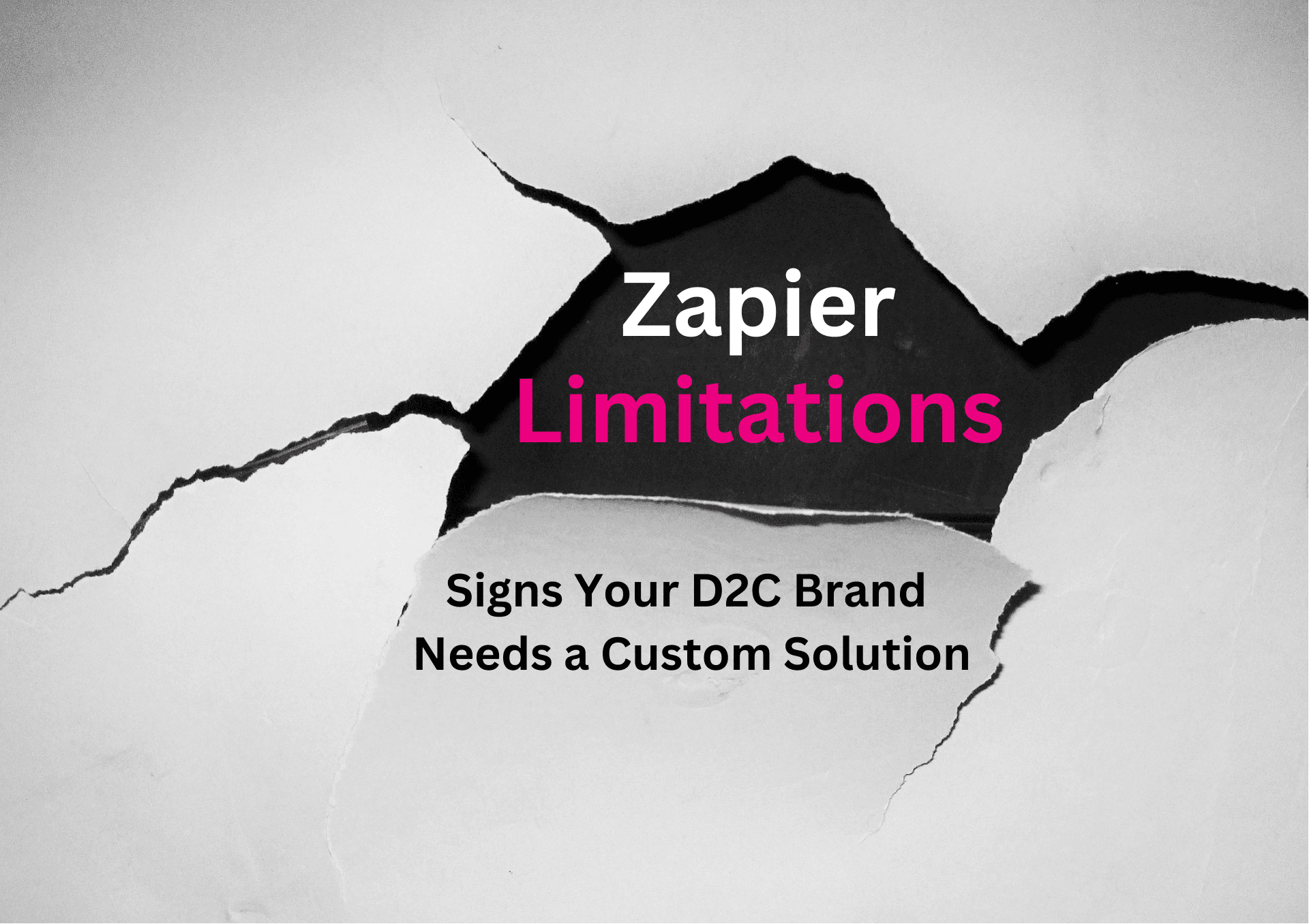For direct-to-consumer brands, efficiency is everything. Every decision, every tool, every process directly impacts the relationship with the end customer. That’s why, whether you're in the wellness, beauty, fitness, or fashion sector, you've likely tapped into the power of tools like Zapier to supercharge your brand's operations. And why not? Zapier offers a straightforward way to integrate apps, automate workflows, and streamline tasks.
BUT here's the deal: while Zapier is a game-changer for many brands just starting out, there might come a time when it feels a bit...limiting. 🤨
Does your brand consistently run into automation glitches? Are you feeling the pinch of scaling costs? Or perhaps you're getting that nagging feeling that your workflows are just too intricate for what Zapier offers? It's a reality many mature D2C brands face.
Don't get us wrong—Zapier is a phenomenal tool. But recognizing its limitations and knowing when to seek a custom solution can be the difference between staying efficient and getting bogged down in automation hiccups.
Let's dive in and explore the signs that your D2C brand might be outgrowing Zapier.
The Strengths of Zapier
Zapier has been nothing short of a revolution for countless brands. Let’s start by giving credit where it’s due and shine a light on what makes Zapier such an asset for D2C businesses.
Easy Integration: Seamlessly connects with over 3,000 apps, from CRM systems to marketing tools.
No-Code Magic: Automation without needing developers. Set triggers and actions in a few clicks.
Scalability: Perfect for both startups and growing brands, Zapier adapts as your business evolves.
Time & Cost Savings: Reduces manual tasks, leading to significant savings in resources and time.
While these strengths make Zapier a staple for many brands, it's essential to understand that no tool is a one-size-fits-all solution. As your brand scales, nuances and unique challenges emerge. And sometimes, these challenges require a more tailored approach.
Recognizing the First Signs of Outgrowing Zapier
As a brand expands, the demands on its tools grow proportionately. Knowing when you're reaching the edges of what Zapier can offer is crucial for maintaining your brand's efficiency. Look out for the following signs:
Frequent Failures or Glitches: Experiencing automation hiccups more often than not? If your Zaps are frequently failing, causing disruptions in your day-to-day operations, it's a sign you might be pushing its limits.
Workflow Complexities: D2C brands often have intricate, multi-step workflows. If you find that Zapier can't quite replicate or accommodate these processes efficiently, you might be in need of a more robust solution.
Missing Integrations: Does your brand rely on platforms or tools that Zapier doesn't support? Or perhaps the native integrations available don't delve deep enough to cater to your specific needs? These gaps can be indicative of outgrowing its capabilities.
Cost-Benefit Mismatch: Scaling often means more zaps, more tasks, and thus, moving to higher-tiered pricing plans. But if the costs start outweighing the benefits or if desired functionalities are absent even in premium plans, it's time to reconsider.
Recognizing these signs early on can prevent future headaches and pave the way for a smooth transition to a solution that better aligns with your brand's needs.
The Potential Risks of Ignoring the Signs
Not addressing the signs that you're outgrowing Zapier can lead to more than just minor hiccups. The real dangers lie in the broader implications for your brand:
Brand Reputation at Stake: In the D2C world, a seamless customer experience is vital. Operational inefficiencies or system bottlenecks can result in customer frustration, which, in turn, can harm your brand's reputation and trustworthiness.
Financial Strain: Every penny counts in the competitive landscape. Using a tool not aligned with your scaling operations might mean excessive costs without the desired outcomes. This could tighten your budget in areas where you need flexibility, like marketing or product innovation.
Missed Market Opportunities: D2C brands thrive on agility and innovation. Being constrained by an automation tool can slow down your ability to launch new campaigns, products, or sales strategies. Every day of delay might mean a missed market opportunity.
Acknowledging these risks and being prepared to transition to a solution that matches your growth ensures you stay ahead of the curve, safeguarding both your brand and bottom line.
The Prospects of Custom Solutions
So you've recognized one or more of the signs we mentioned earlier. The burning question then becomes: What now? Do you stick it out and hope for the best or pivot to a solution that truly aligns with your evolving needs? Let's explore the promising horizon of custom solutions.
Bespoke Fit: No two brands are exactly alike, and neither should their automation solutions be. With a custom approach, you get a system precisely crafted to your brand's unique needs, nuances, and ambitions.
Seamless Integrations: With a custom solution, you're not limited by predefined Zaps or existing integrations. If there's a specific platform or tool you want to incorporate into your workflow, a custom system can make that connection smooth and efficient.
Scalability on Your Terms: As your brand grows, your custom solution grows with you. You're not bound by the constraints of a platform's tiered plans or functionalities. Instead, you define the pace, and the system adapts, ensuring you're always equipped to handle the next big step in your brand's journey.
Embracing a custom solution is about claiming the driver's seat, ensuring your brand's tools are not just responsive but proactive, anticipating your needs and scaling in tandem with your vision.
Charting the Path Forward: Making the Switch
Recognizing the need for change is only half the battle. The next step? Strategically transitioning to a system that propels your brand forward. Let's guide you through that journey:
Evaluate Your Current Workflows: Begin by taking stock of your current automations and workflows in Zapier. Understand which ones are vital, which are less crucial, and any gaps or inefficiencies that exist.
Determine Your Must-Haves: Identify the non-negotiable features and integrations your business needs. This will shape the foundation of your custom solution.
Seek Expertise: Don't go it alone. Find a tech partner that understands the intricacies of D2C operations. Their insights will be invaluable in creating a solution that truly fits your brand.
Smooth Transition: It's crucial to ensure minimal disruption during the switch. Work with your tech partner to develop a phased transition plan, allowing you to test and refine the new system without jeopardizing current operations.
Continued Support: Post-transition, ensure you have access to ongoing support. As your brand evolves, you want the assurance that your tech platform can adapt seamlessly.
Making the leap to a custom solution isn't just a tech decision; it's a strategic move. By navigating this path with precision and the right partners, you're setting the stage for your brand's next big chapter. Think of it as upgrading your toolkit for the journey ahead.
Conclusion
Every tool has its moment—a sweet spot where it perfectly aligns with a brand's needs. But as your brand evolves, it's crucial to acknowledge when a once-beloved tool starts to feel like a tight shoe. It's not about dismissing the value it brought, but rather recognizing the growth that's nudging you towards a broader horizon.
The beauty of custom solutions is that they're tailored to your unique journey. For D2C brands reaching the limits of standard automation tools, going custom means harnessing technology that scales, adapts, and evolves with you. It's more than just a switch—it's a commitment to pushing boundaries and realizing your brand's fullest potential.
That's where WHCP steps in. Whether you're looking to transition completely or simply augment your existing setup (yes, even with Zapier!), we tailor our solutions to fit your journey.


